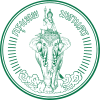
Back Bangkok ACE Bangkok Afrikaans Bangkok ALS ባንግኮክ Amharic Bangkok AN بانكوك Arabic بانكوك ARY بانكوك ARZ বেংকক Assamese Bangkok AST
Bangkok
กรุงเทพมหานคร | |
|---|---|
| Krung Thep Maha Nakhon | |
 From top, left to right: Sathon business district, Wat Benchamabophit, Grand Palace, Giant Swing, Democracy Monument, and Wat Arun | |
|
| |
| Nickname(s): City of Angels, The Big Mango | |
| Coordinates: 13°45′09″N 100°29′39″E / 13.75250°N 100.49417°E[1] | |
| Country | Thailand |
| Region | Central Thailand |
| First settlements | c. 15th century |
| Founded as capital | 21 April 1782 |
| Re-incorporated | 13 December 1972 |
| Founded by | Rama I |
| Governing body | Bangkok Metropolitan Administration |
| Government | |
| • Type | Special administrative area |
| • Governor | Chadchart Sittipunt (Indp.) |
| Area | |
• City | 1,568.737 km2 (605.693 sq mi) |
| • Metro | 7,761.6 km2 (2,996.8 sq mi) |
| Elevation | 1.5 m (4.9 ft) |
| Population (2010 census)[4] | |
• City | 8,305,218 |
• Estimate (2021)[5] | 9,034,000 |
| • Density | 5,300/km2 (14,000/sq mi) |
| • Metro | 17,400,000 |
| • Metro density | 2,200/km2 (5,800/sq mi) |
| Demonym | Bangkokian |
| GDP | |
| • City | baht 5.747 trillion (US$ 164 billion) (2022) |
| • Metro | baht 8.096 trillion (US$ 232 billion) (2022) |
| Time zone | UTC+07:00 (ICT) |
| Postal code | 10### |
| Area code | 02 |
| ISO 3166 code | TH-10 |
| Website | main |
Bangkok,[a] officially known in Thai as Krung Thep Maha Nakhon[b] and colloquially as Krung Thep,[c] is the capital and most populous city of Thailand. The city occupies 1,568.7 square kilometres (605.7 sq mi) in the Chao Phraya River delta in central Thailand and has an estimated population of 9.0 million as of 2021, 13% of the country's population. Over 17.4 million people (25%) live within the surrounding Bangkok Metropolitan Region as of the 2021 estimate, making Bangkok a megacity and an extreme primate city, dwarfing Thailand's other urban centres in both size and importance to the national economy.[5]
Bangkok traces its roots to a small trading post during the Ayutthaya Kingdom in the 15th century, which eventually grew and became the site of two capital cities, Thonburi in 1767 and Rattanakosin in 1782. Bangkok was at the heart of the modernization of Siam during the late-19th century, as the country faced pressures from the West. The city was at the centre of the country's political struggles throughout the 20th century, as Siam—later renamed Thailand—abolished absolute monarchy, adopted constitutional rule, and underwent numerous coups and several uprisings. The city, incorporated as a special administrative area under the Bangkok Metropolitan Administration in 1972, grew rapidly during the 1960s through the 1980s and now exerts a significant impact on Thailand's politics, economy, education, media and modern society.
The Asian investment boom in the 1980s and 1990s led many multinational corporations to locate their regional headquarters in Bangkok. The city is now a regional force in finance, business and pop culture. It is an international hub for transport and health care, and has emerged as a centre for the arts, fashion, and entertainment. The city is known for its street life and cultural landmarks, as well as its red-light districts. The Grand Palace and Buddhist temples including Wat Arun and Wat Pho stand in contrast with other tourist attractions such as the nightlife scenes of Khaosan Road and Patpong. Bangkok is among the world's top tourist destinations, and has been named the world's most visited city consistently in several international rankings.
Bangkok's rapid growth coupled with little urban planning has resulted in a haphazard cityscape and inadequate infrastructure.[9] Despite an extensive expressway network, an inadequate road network and substantial private car usage have led to chronic and crippling traffic congestion, which caused severe air pollution in the 1990s. The city has since turned to public transport in an attempt to solve the problem, operating 10 urban rail lines and building other public transit; however, congestion remains a prevalent issue.
- ^ a b Cite error: The named reference
BMA geowas invoked but never defined (see the help page). - ^ Cite error: The named reference
Tangchonlatipwas invoked but never defined (see the help page). - ^ Cite error: The named reference
Sinsakulwas invoked but never defined (see the help page). - ^ "Table 1 Population by sex, household by type of household, changwat and area" (PDF). The 2010 Population and Housing Census: Whole Kingdom. National Statistical Office. 2012. p. 32. Archived from the original (PDF) on 12 March 2019. Retrieved 6 September 2020.
- ^ a b c "Gross Regional and Provincial Product (GPP)". nesdc.go.th. Archived from the original on 17 July 2024. Retrieved 24 April 2024.
- ^ "Bangkok". British and World English Dictionary. Oxford Dictionaries. Archived from the original on 5 August 2017. Retrieved 4 August 2017.
- ^ a b "Definition of "Bangkok"". Collins English Dictionary (online). HarperCollins. Archived from the original on 28 April 2021. Retrieved 26 March 2014.
- ^ "Bangkok". US English Dictionary. Oxford Dictionaries. Archived from the original on 5 August 2017. Retrieved 4 August 2017.
- ^ Cite error: The named reference
Medhiwas invoked but never defined (see the help page).
Cite error: There are <ref group=lower-alpha> tags or {{efn}} templates on this page, but the references will not show without a {{reflist|group=lower-alpha}} template or {{notelist}} template (see the help page).




